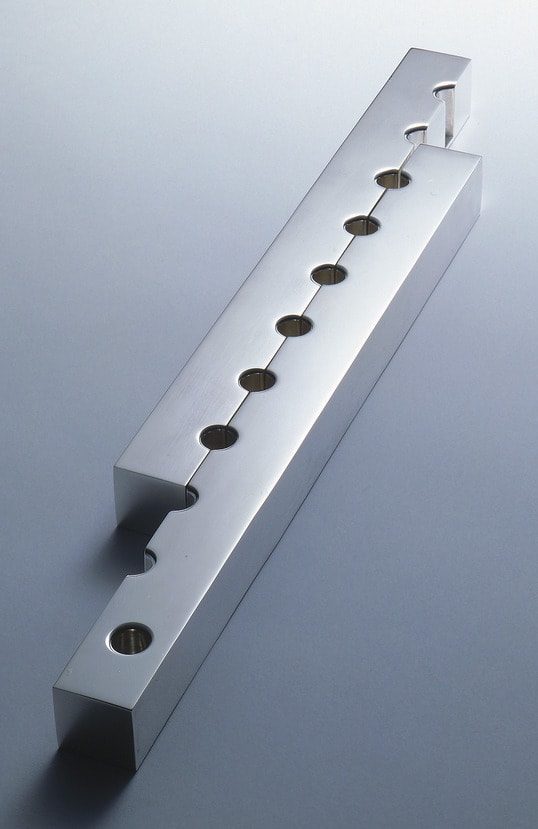
- Object Name:
- Hanukkah Lamp
- Artist/Maker:
- Zelig Segal
- Bio:
- Israeli, 1933-2015
- Place Made:
- Jerusalem (Israel)
- Date:
- 1986
- Medium:
- Copper alloy: cast and silver-plated
- Dimensions:
- 1 1/4 × 12 5/8 × 2 in. (3.2 × 32 × 5.1 cm)
- Credit Line:
- Purchase: Judaica Acquisitions Fund
- Accession Number:
- 1986-120a-b
Not On View
Zelig Segal was an Israeli artist who was passionately interested in creating ritual objects that brought a fresh, imaginative approach to Jewish ceremony. He strove for modern design solutions that linked technological innovations with ancient traditions. Simple, geometricized shapes and an aesthetic of refined simplicity characterized his work, which was profoundly colored by his knowledge and training in Judaism and its traditions. Segal received his religious training in a heder and yeshivah and studied metalsmithing and Judaica at Jerusalem's New Bezalel School under Ludwig Y. Wolpert and David Gumbel, two of the most influential leaders in Jewish ceremonial design of the twentieth century. He graduated in and later headed the school's Department of Gold and Silversmithing from 1964 to 1968.
The juxtaposing of negative and positive elements is a recurring theme in Segal's work. The artist found myriad ways to express this concept--sometimes using the profiles to create a plus/minus tension, other times working with surface finishes to create a sense of differentiation. Segal ingeniously continued his exploration of positive and negative space with this 1986 Hanukkah lamp. The lamp simply consists of two sliding bars each notched with eight semicircular openings. When aligned, the notches form receptacles for candles. The bars are made to slide-so that as each day of Hanukkah passes, the number of holes can be increased to mark the passing of a new day of the celebration. Segal's design created a lamp which is reduced to its most essential elements-a support with eight holes and a shamash. The shemash is placed at the top end of one of the bars-subtly differentiated from the other candle receptacles by its distance. Segal's lamp seems somehow caught between contemporary sculpture and modern machinery, and yet is informed by Jewish tradition. The artist said about the meaning of this lamp: "The two halves are in remembrance of the destruction of the Temple. When the Messiah comes it will become one unit. I wanted people to see the miracle of Hanukkah in the Hanukkah lamp by the fact that you start with the first candle, and then the second day the second candle" (artist's statement, 2003). Segal created a Hanukkah lamp that is more than a static object. His work is active--it is altered not only by the illumination of additional candles, but also by the actual shifting of the two bars so that a new receptacle is created each day. This subtlety is yet another example of Segal's thoughtful and innovative approach to ceremonial art.
The juxtaposing of negative and positive elements is a recurring theme in Segal's work. The artist found myriad ways to express this concept--sometimes using the profiles to create a plus/minus tension, other times working with surface finishes to create a sense of differentiation. Segal ingeniously continued his exploration of positive and negative space with this 1986 Hanukkah lamp. The lamp simply consists of two sliding bars each notched with eight semicircular openings. When aligned, the notches form receptacles for candles. The bars are made to slide-so that as each day of Hanukkah passes, the number of holes can be increased to mark the passing of a new day of the celebration. Segal's design created a lamp which is reduced to its most essential elements-a support with eight holes and a shamash. The shemash is placed at the top end of one of the bars-subtly differentiated from the other candle receptacles by its distance. Segal's lamp seems somehow caught between contemporary sculpture and modern machinery, and yet is informed by Jewish tradition. The artist said about the meaning of this lamp: "The two halves are in remembrance of the destruction of the Temple. When the Messiah comes it will become one unit. I wanted people to see the miracle of Hanukkah in the Hanukkah lamp by the fact that you start with the first candle, and then the second day the second candle" (artist's statement, 2003). Segal created a Hanukkah lamp that is more than a static object. His work is active--it is altered not only by the illumination of additional candles, but also by the actual shifting of the two bars so that a new receptacle is created each day. This subtlety is yet another example of Segal's thoughtful and innovative approach to ceremonial art.
Information may change as a result of ongoing research.